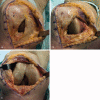Innervation of the distal part of the vastus medialis muscle is endangered by splitting its muscle fibers during total knee replacement: an anatomical study using modified Sihler's technique
- PMID: 33228445
- PMCID: PMC8158273
- DOI: 10.1080/17453674.2020.1851459
Innervation of the distal part of the vastus medialis muscle is endangered by splitting its muscle fibers during total knee replacement: an anatomical study using modified Sihler's technique
Abstract
Background and purpose - The distal part of the vastus medialis muscle is an important stabilizer for the patella. Thus, knowledge of the intramuscular nerve course and branching pattern is important to estimate whether the muscle's innervation is at risk if splitting the muscle. We determined the intramuscular course of the nerve branches supplying the distal part of the vastus medialis muscle to identify the surgical approach that best preserves its innervation.Material and methods - 8 vastus medialis muscles from embalmed anatomic specimens underwent Sihler's procedure to make soft tissue translucent while staining the nerves to study their intramuscular course. After dissection under transillumination using magnification glasses all nerve branches were evaluated.Results - The terminal nerve branches were located in different layers of the muscle and ran mostly parallel but also transverse to the muscle fibers. In half of the cases, the latter formed 1 to 3 anastomoses and coursed close to the myotendinous junction. Additionally, most of the branches extended into the ventromedial part of the knee joint capsule.Interpretation - To preserve the innervation of the distal part of the vastus medialis muscle, any split of the muscle during surgical approaches to the knee joint should be avoided.
Figures




Similar articles
-
Anatomic consideration of nerve supply to the vastus medialis in knee surgery.Clin Orthop Relat Res. 2004 Jun;(423):157-60. doi: 10.1097/01.blo.0000128642.61260.b3. Clin Orthop Relat Res. 2004. PMID: 15232442
-
Surgical technique: vastus medialis and vastus lateralis as flap transfer for knee extensor mechanism deficiency.Clin Orthop Relat Res. 2013 Jan;471(1):221-30. doi: 10.1007/s11999-012-2532-z. Clin Orthop Relat Res. 2013. PMID: 22992869 Free PMC article.
-
Intramuscular neural distribution of the vastus medialis for botulinum neurotoxin injection: application to spasticity.Surg Radiol Anat. 2024 Dec;46(12):2067-2073. doi: 10.1007/s00276-024-03482-y. Epub 2024 Oct 14. Surg Radiol Anat. 2024. PMID: 39400571
-
Innervation of the Face Studied Using Modifications to Sihler's Technique in a Primate Model.Plast Reconstr Surg. 2008 Apr;121(4):1188-1205. doi: 10.1097/01.prs.0000305563.77782.35. Plast Reconstr Surg. 2008. PMID: 18349636 Review.
-
Innervation of the Anterior Capsule of the Human Knee: Implications for Radiofrequency Ablation.Reg Anesth Pain Med. 2015 Jul-Aug;40(4):363-8. doi: 10.1097/AAP.0000000000000269. Reg Anesth Pain Med. 2015. PMID: 26066383 Review.
References
-
- Calguner E, Erdogan D, Elmas C, Bahcelioglu M, Gozil R, Ayhan M S.. Innervation of the rat anterior abdominal wall as shown by modified Sihler’s stain. Med Princ Pract 2006; 15(2): 98–101. - PubMed
-
- Clayton M L, Thirupathi R.. Patellar complications after total condylar arthroplasty. Clin Orthop Rel Res 1982; 170: 152–5. - PubMed
-
- Cooper R E Jr, Trinidad G, Buck W R.. Midvastus approach in total knee arthroplasty: a description and a cadaveric study determining the distance of the popliteal artery from the patellar margin of the incision. J Arthroplasty 1999; 14(4): 505–8. - PubMed
-
- Dalury D F, Jiranek W A.. A comparison of the midvastus and paramedian approaches for total knee arthroplasty. J Arthroplasty 1999; 14(1): 33–7. - PubMed
-
- Dalury D F, Snow R G, Adams M J.. Electromyographic evaluation of the midvastus approach. J Arthroplasty 2008; 23(1): 136–40. - PubMed
MeSH terms
LinkOut - more resources
Full Text Sources
Medical
Miscellaneous
